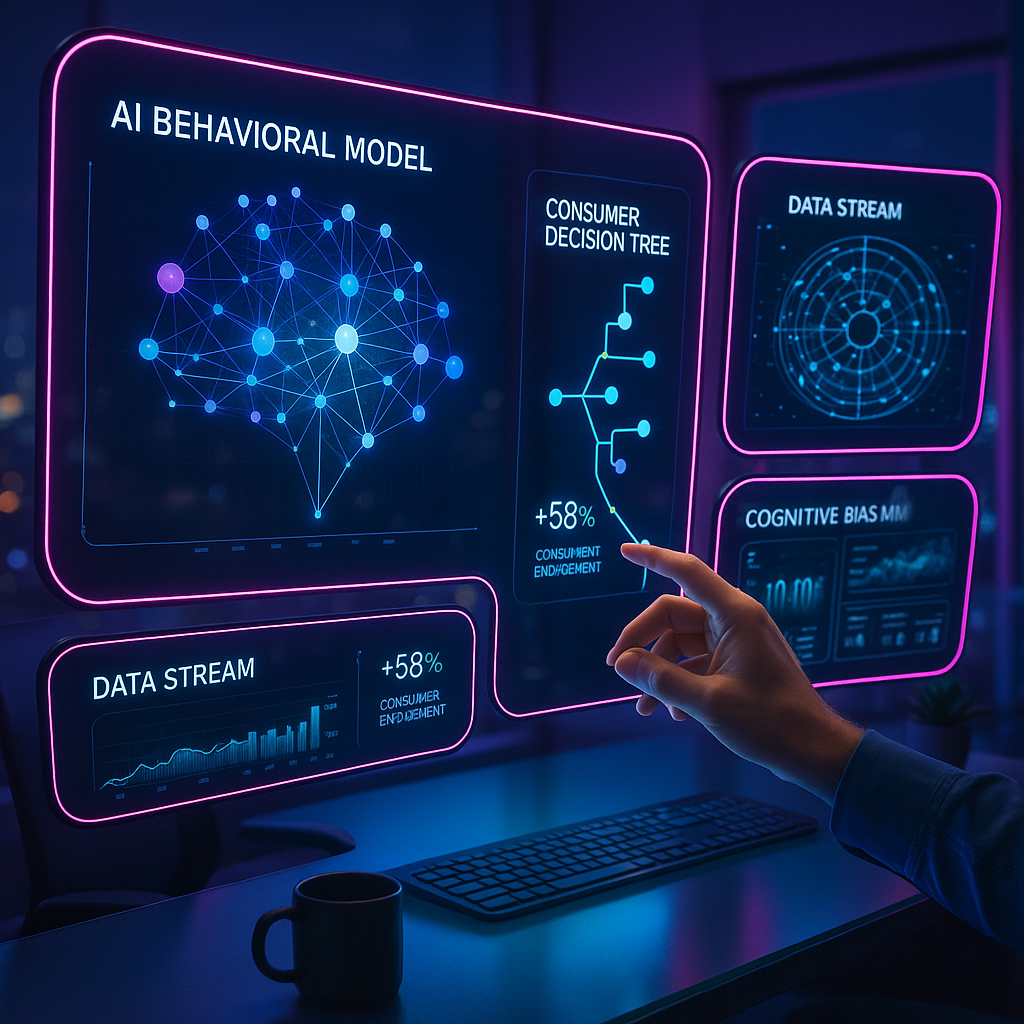Key Takeaways
- AI leverages behavioral economics to decode real-world consumer biases: By integrating psychological mechanisms such as cognitive bias and choice architecture, artificial intelligence systems now move far beyond traditional data analysis. These technologies can simulate authentic consumer behaviors and predict responses with a precision previously unattainable. This is reshaping business expectations across industries, including retail, healthcare, finance, and beyond.
- Hyper-personalized marketing harnesses decision simulation: AI-powered consumer modeling applies rich behavioral insights to enable brands to craft campaigns that respond dynamically to individual motivations. This approach leads to more compelling and, at times, unconsciously persuasive buyer journeys in sectors as varied as e-commerce, financial services, healthcare engagement, and educational outreach.
- Algorithmic influence can reshape markets and mindsets: The steady feedback loop from AI simulations allows businesses to redesign products, pricing strategies, and user experiences. As these systems nudge public choices at scale, they can amplify subtle psychological effects that legacy analytics would miss. They can transform markets, healthcare access, educational choices, and even legal compliance in ways that challenge old paradigms.
- Simulation-driven strategy accelerates business foresight: By modeling “what-if” scenarios rooted in behavioral science, AI equips organizations to anticipate market reactions, test interventions in silico, and refine their strategies with an agility and precision unattainable through static modeling. These advances benefit not only traditional businesses, but also healthcare providers seeking better patient outcomes, educators building adaptive curriculum pathways, and environmental organizations modeling resource management.
- Ethics leap to the forefront amid mounting user concern: With 76% of users demanding greater transparency from AI systems and more than half expressing anxieties about data privacy, ethical considerations are now unavoidable. Responsible consumer modeling must balance business objectives with fundamental rights to informed consent, algorithmic fairness, and rigorous privacy safeguards.
- Responsible AI demands transparent, explainable models: As AI’s influence over consumer behavior deepens, the need for interpretable and auditable automated decisions becomes critical. Both business leaders and technologists are challenged to expose the logic behind AI-driven outcomes and ensure that unintended biases or manipulative nudges do not go unchecked in pursuit of optimization.
- The future calls for a convergence of data science, psychology, and philosophy: Building AI that truly respects and understands human decision-making necessitates blending insights from diverse disciplines. This interdisciplinary approach advances market research, protects user autonomy, and helps cultivate lasting trust in technology-mediated interactions.
These pivotal insights invite readers to move beyond the numbers, venturing into a landscape where algorithms not only forecast actions but help write the evolving script of consumer experience itself. In this exploration, we’ll dissect the operation of behavioral economics AI, probe its profound advantages and emerging pitfalls, and clarify what genuine ethical stewardship means in our simulation-driven age.
Introduction
Consumer decisions are seldom rational. Where algorithms once simply predicted these decisions, they now participate in shaping them. The rise of behavioral economics AI fuses the intricate psychology of choice with machine-level precision. This establishes a frontier where consumer modeling and decision simulation not only anticipate what people may do, but also actively guide their paths in real time.
This convergence of disciplines is fundamentally reshaping how brands, healthcare institutions, financial organizations, and educators interpret and influence motivation. By leveraging biases, sculpting choice architecture, and deploying hyper-personalized strategies, organizations are reimagining marketing, design, and interactive engagement. Yet, as AI-driven decision-making gains sophistication, new questions of algorithmic transparency, user autonomy, and ethical stewardship become ever more urgent. Let us examine how behavioral economics AI is transforming consumer modeling, revealing both its transformative opportunities and the critical responsibilities it demands from business, technology, and society at large.
AI-Enhanced Behavioral Economics: Core Integration Principles
The integration of artificial intelligence with behavioral economics is a paradigm shift in decoding human decision-making. Machine learning algorithms now scrutinize vast and varied datasets (tracking clickstreams in online retail, choices made in financial planning apps, patient behaviors in healthcare portals, and learning patterns in adaptive education systems). This allows them to discover subtle psychological triggers and cognitive biases previously overlooked by classical economic models. The outcome is a suite of frameworks that can capture, and even anticipate, the dynamic dance between rational consideration and emotional impulse.
Stay Sharp. Stay Ahead.
Join our Telegram Channel for exclusive content, real insights,
engage with us and other members and get access to
insider updates, early news and top insights.
 Join the Channel
Join the Channel
Neural Networks and Cognitive Bias Mapping
Modern deep learning architectures excel at identifying order within the seeming chaos of consumer choice. These AI systems can pinpoint when anchoring bias shapes how people perceive pricing, or when loss aversion motivates risk-averse investment or purchasing behavior. Take the case of a global e-commerce platform that deployed neural networks to map the effects of product framing. Small shifts in how products were presented led to a 32% increase in completed purchases simply by harnessing loss aversion and framing effects. Similarly, a healthcare provider applied these techniques to nudge patients toward preventive care programs, increasing engagement rates by 19%.
The true power of this technology lies in its capacity to process and weigh multiple behavioral variables simultaneously. Where traditional analytics might focus solely on price or demographic data, cutting-edge AI systems synthesize factors such as:
- Social proof in the form of user testimonials or peer activity
- Urgency signals, including limited-time offers and countdowns
- Choice architecture (the structured arrangement of options)
- Emotional state insights, gathered from language or interaction patterns
- Cultural context or geographic variance
Predictive Analytics and Decision Pathways
Contemporary AI does more than observe. It learns and anticipates. Through reinforcement learning and advanced predictive analytics, these platforms construct branching decision trees that illuminate the likely paths a consumer may take. For instance, a major financial services company used reinforcement learning to model investor decision-making during market volatility. The result was a 45% improvement in accurately forecasting portfolio adjustments, allowing the firm to preemptively tailor communication and offer personalized financial advice at critical junctures.
In healthcare, predictive models are now used to identify at-risk patients based on subtle shifts in appointment scheduling, medication adherence, or reported symptoms. In education, algorithms can forecast when a student might disengage, enabling timely interventions.
Advanced Consumer Modeling Methodologies
The methodology underlying modern consumer modeling is evolving rapidly. Unlike static demographic profiles, today’s machine learning approaches create fluid, adaptive personas that update in real time as consumer behaviors evolve.
Dynamic Segmentation Systems
The days of broad-brush market segmentation are fading. AI-powered micro-segmentation enables continuous reconfiguration of segments based on shifting behavior. Individuals may fluidly belong to multiple overlapping categories (such as eco-conscious spenders, value-driven bargain hunters, or experience seekers) depending on context and time. A leading retail analytics firm applied this approach, identifying 27% more high-value customers than with conventional segmentation. In healthcare, dynamic segmentation allows for patient engagement strategies that can change based on adherence risk levels. In finance, it supports personalized product recommendations driven by spending behavior rather than static demographic data.
Temporal Pattern Recognition
AI is particularly adept at uncovering the weak signals that emerge over time. By recognizing these patterns (seasonal variations, gradual changes in preferences, external shocks like pandemics or economic shifts), organizations can adapt ahead of the curve. Examples include:
- Retailers who track holiday spending patterns and adjust inventory in real time.
- Financial institutions that detect shifts in risk appetite linked to economic news cycles.
- Educators observing adjustments in student learning preferences following major social events.
- Health organizations monitoring patient engagement in wellness programs throughout the year.
Practical Applications in Decision Simulation
The practical implementation of behavioral economics AI is redefining how organizations simulate and test strategies across industries.
Market Response Simulation
Advanced AI platforms now generate virtual markets populated with millions of simulated consumers, each modeled with distinct behavioral tendencies. A consumer goods company achieved an 85% accuracy rate when predicting real-world product launch outcomes using such simulations. In finance, these tools enable “stress-testing” of new investment products. In environmental science, they estimate how communities might respond to policy incentives for green energy adoption. In education, they support curriculum developers seeking to forecast the impact of new teaching methods or assessment strategies.
Personalization Engines
Contemporary AI personalization systems synthesize behavioral, contextual, and emotional data to deliver profoundly targeted experiences. They move beyond simple product suggestions to orchestrate entire customer journeys, aligning messages and offers with:
- Historical buying or interaction patterns
- Current emotional tone (inferred from text or voice)
- Situational cues (weather, location, device)
- Social context (peer behavior, family profiles)
- Temporal factors (time-of-day engagement trends)
This approach is not limited to retail. Healthcare systems use personalization engines to offer timely nudges for medication adherence or healthy choices. Financial platforms craft bespoke product bundles and alerts, while online education services dynamically adapt lesson difficulty and feedback.
Ethics and Transparency in AI-Driven Decision Systems
As the reach of behavioral economics AI expands, so too do concerns surrounding ethics and transparency. With 76% of consumers highlighting the need for transparent AI, and more than half voicing privacy concerns, these issues demand urgent attention.
Privacy-Preserving Analysis
Cutting-edge organizations are turning to privacy-enhancing technologies such as federated learning (training algorithms collaboratively without sharing raw personal data) and differential privacy (introducing statistical noise to mask individual contributions). For example, a financial technology firm used these tools to improve prediction accuracy in credit scoring models by 40%. At the same time, the company reduced exposure of sensitive personal data by 65%. Hospitals and insurers have adopted similar techniques to build predictive patient care models without exposing confidential health records.
Explainable AI Integration
Regulators, consumers, and business leaders are placing increasing value on transparent, auditable models. Organizations are integrating tools that visualize decision paths, assign confidence levels to predictions, flag bias sources, and assess the impact of AI-driven interventions. Whether used in credit decisions, healthcare triage, or educational placement, such explainability is becoming central to compliance and trust-building. Interestingly, companies demonstrating proactive transparency in their AI systems report up to a 23% improvement in customer retention. That’s a competitive edge extending across sectors.
Responsible AI implementation has shifted from a compliance obligation to a strategic asset. Companies that practice algorithmic fairness cultivate reputational strength and foster greater engagement not only with consumers, but also with partners, regulators, and talent in a competitive marketplace.
Emerging Trends and Future Directions
The pace of change within behavioral economics AI is rapid and multi-directional. Quantum computing promises to accelerate the process of modeling countless behavioral scenarios, vastly broadening the horizons for predictive and strategic insight. Edge computing, meanwhile, is empowering real-time decision support for retailers on the sales floor, financial advisors in client meetings, healthcare workers in clinical settings, and educators in dynamic classroom environments.
Stay Sharp. Stay Ahead.
Join our Telegram Channel for exclusive content, real insights,
engage with us and other members and get access to
insider updates, early news and top insights.
 Join the Channel
Join the Channel
Simultaneously, interdisciplinary collaboration is becoming the norm. Data scientists, behavioral psychologists, ethicists, and philosophers are joining forces to ensure not just accuracy, but ethical depth in modeling human behavior. Initiatives are emerging to standardize explainability, foster inclusive design, and explicitly study the unintended social consequences of nudging and simulation.
Environmental science is harnessing behavioral economics AI to model climate policy impacts and promote sustainable habits. Legal professionals deploy these models to enhance compliance monitoring and contract risk assessment. The convergence is underscoring the need for broader literacy in how these technologies operate and for public dialogue about their place in society.
Conclusion
The integration of artificial intelligence and behavioral economics represents a revolutionary leap in our ability to decode (and subtly influence) the intricate realities of human decision-making. With technologies that bridge neural networks, predictive analytics, and dynamic segmentation, organizations now have an unprecedented toolkit to map not just what people do, but why they do it. This empowers businesses, healthcare providers, educators, and even environmental advocates to meet individuals where they are, crafting experiences that resonate deeply and adapt in real time.
Yet, as AI systems increasingly participate in scripting consumer experience, their power must be matched by a commitment to ethics, transparency, and user autonomy. Trust is fast becoming the defining currency of the AI era. Organizations that prioritize explainable and fair algorithms, data stewardship, and genuine user empowerment will not just win today’s market. They will set the standard for responsible innovation tomorrow.
Looking to the future, those who embrace a convergence of data science, behavioral insight, and philosophical inquiry will lead in shaping technology that enhances, rather than undermines, our collective autonomy and well-being. Quantum and edge computing will expand the toolkit, but the essential challenge remains. How do we ensure that AI’s alien logic continues to illuminate (and serve) our most human values? The next phase belongs to those willing not just to adopt these advancements, but to wield them thoughtfully, anticipating change and shaping it with wisdom. In exploring these alien minds, we are ultimately searching for deeper understanding of our own.





Leave a Reply